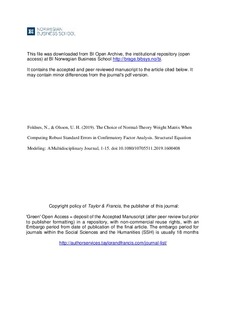The choice of normal-theory weight matrix when computing robust standard errors in confirmatory factor analysis
Journal article, Peer reviewed
Accepted version
Permanent lenke
http://hdl.handle.net/11250/2596992Utgivelsesdato
2019Metadata
Vis full innførselSamlinger
- Publikasjoner fra CRIStin - BI [1015]
- Scientific articles [2181]
Originalversjon
https://doi.org/10.1080/10705511.2019.1600408Sammendrag
Robust standard errors are of central importance in confirmatory factor models. In calculating these statistics a central ingredient is the inverse of the asymptotic covariance matrix of second-order moments calculated under the assumption of normality. Currently, two ways of estimating this matrix are employed in software packages. One approach uses the sample covariance matrix, the other the model-implied covariance matrix. Previous research based on a small confirmatory factor model demonstrated that the latter approach yielded a slight improvement in standard error performance. The present study argues theoretically that the discrepancy between the two approaches increases in models where there are few model parameters relative to p(p+1)/2, where p is the number of observed variables. We present simulation results that support this claim, in both small and large correctly specified models, across a large variety of non-normal conditions. We recommend the model-implied covariance matrix for robust standard error computation.
